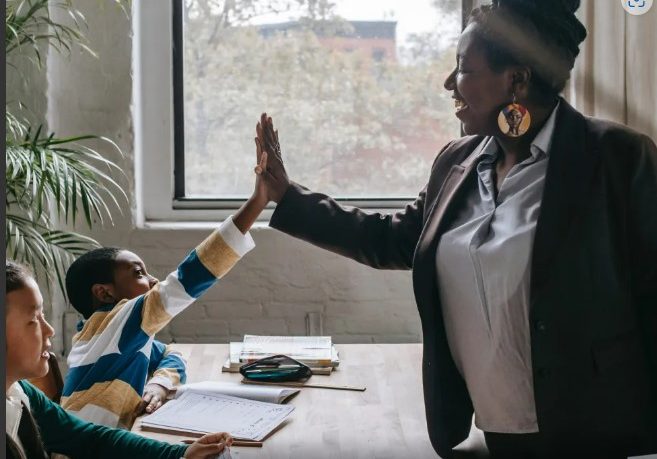By Aziah Siid, Word in Black
Whether it’s autism or dyslexia, emotional disturbances, or a hearing impairment, it’s easy for students with disabilities to get lost in the classroom. As a result, they might behave in ways their teachers and peers don’t understand — and their teacher may lack the training, or empathy, to meet their needs.
These behaviors are often criminalized, and students with disabilities find themselves funneled into the juvenile justice system — the school-to-prison pipeline.
But a new report, “Unlocking Futures” by the National Center for Learning Disabilities, seeks to call attention to the intersectional failure of the educational, justice, and disability systems to provide youth with disabilities the education they deserve during their time in juvenile detention.
We’ve seen an increased discussion on the criminalization of youths and school discipline practices and what that means for students of color and students of color with disabilities,LINDSAY KUBATZKY, DIRECTOR OF POLICY AT NCLD
According to the report, as many as 70% of youths involved in the juvenile justice system have a disability. Instead of a linear pipeline where kids go straight from school to incarceration, the report notes that “justice-involved youth with disabilities are likely to rotate in and out from school to prison and back again.”
In that system, there are even fewer resources for students to thrive academically and emotionally.
“We’ve seen an increased discussion on the criminalization of youths and school discipline practices and what that means for students of color and students of color with disabilities,” Lindsay Kubatzky, director of policy at NCLD, tells Word In Black. “We wanted to dig into this issue to determine what was happening there and what possible solutions we can elevate to decrease the number of students with disabilities who are being put into a juvenile justice system that’s not serving them.”
It Starts in the Classroom
The NCLD’s research focused on K-12 children with a range of disabilities, and they found a student’s path into the juvenile justice system often begins with something as simple as misinterpreted behavior, placement in a more restrictive educational setting, or increased discipline at higher rates than their peers.
All students have a right to learn in public education, and then we also believe all students with disabilities have a right to support and resources to access that curriculum,”JESSICA SNYDMAN, A POLICY RESEARCH ASSOCIATE AT NCLD
Jessica Snydman, a policy research associate at NCLD, says there is a need for educators and school leaders to understand students with disabilities and handle their behavior in appropriate ways that don’t land them in the carceral system.
“We did research in 2019 that found that 1 in 3 teachers viewed students with learning or attention issues as laziness,” Snydman. says. “Only 17% felt well prepared to teach students with mild to moderate learning disabilities.”
The Impact of Anti-Black Racism
Data compiled by the ACLU shows that in 2020, Black youths overall were 2.3 times more likely to be arrested than white youths. Students with disabilities are almost three times more likely to be arrested than their nondisabled peers. The intersection of these stats feeds the pipeline into the carceral system.
Black students with disabilities are more likely to be on the receiving end of “exclusionary practices,” which “include both in-and out-of-school suspensions, as well as expulsions and other punitive measures that remove students from the classroom.”
The report points out that “Black boys with disabilities specifically are the most frequently suspended group of students.”
Black girls aren’t faring much better. “Black girls specifically are 2.7x more likely to receive a juvenile justice referral compared to White girls,” wrote the authors.
Probation officers are a really important touch point in that transition, They have a lot of power to either put these students back in the system or support them back into traditional public education”LINDSAY KUBATZKY, DIRECTOR OF POLICY AT NCLD
Being removed from the classroom “has detrimental social, emotional, and academic impacts, causing students to fall behind and disengage from the school community.” The result is that “students are more likely to engage in delinquent behavior.”
Snydman says preventing this cycle starts with schools implementing “reformative justice-based practices, diversion programs, healthy school communities, safe environments,” and avoiding what she calls “school hardening.”
According to the report, school hardening is a phrase that describes common yet ineffective “practices and policies that increase tactical security measures in schools, such as the use of metal detectors, surveillance technology, limiting entrance points, arming teachers, and more.”
“It’s about avoiding going down that pipeline and preventing that,” Syndam says.”
The Juvenile Detention Experience
The average length of a young person’s stay in a juvenile detention facility is 27 days. Regardless of the duration, these facilities are expected to provide students with the same quality of education they would receive in a traditional classroom. But research shows facilities are failing to do so.
“All students have a right to learn in public education, and then we also believe all students with disabilities have a right to support and resources to access that curriculum,” Snydman says. “We see a lot of students with disabilities rights being violated in these systems.”
One recent example can be found in the Charles H. v District of Columbia class action case, which was filed in 2021 against DC Public Schools on behalf of incarcerated students with disabilities at the DC Jail.
According to the case, these youths were denied the education they were mandated to receive according to the Individuals with Disabilities Education Act.
Violations of IDEA in the case include students not being provided instruction or related services according to their individualized education plan, commonly known as an IEP.
Critical services like counseling, speech-language pathology, and other instructional support were not provided to students at the DC Jail, while students in other DC public schools received distance learning through virtual instruction and services.
In February 2022, “the Court found the District in contempt and ordered the District to submit individualized plans to make up for the lost education hours” — a decision that’s being appealed by DC Public Schools.
NCLD’s report notes that “students at the DC Jail continue to struggle with accessing instruction and services related to their disabilities as litigation continues.”
Despite this, through the advocacy work as a result of the case, “the students have made significant gains to ensure that all DC Jail students get the education that they are entitled to and can work towards obtaining their high school diplomas.”
Transitioning Away From the Pipeline
A large part of pushing individuals out of the juvenile justice system and away from the prison pipeline is successfully adjusting them back into life after any time spent in a correctional facility.
The multifaceted transition includes a strong support system, credit transfers, and the presence of caring influential figures, like probation officers or teachers.
“Probation officers are a really important touch point in that transition,” Kubatzky says. “They have a lot of power to either put these students back in the system or support them back into traditional public education.”
Those with individual authority in the cycle can make a difference in a student’s trajectory. The issue of ensuring officers, teachers, and other school staff understand the needs of students with disabilities in these situations in comparison to the average student, is crucial to helping formerly incarcerated students settle back in.
The importance of perspective from other authority figures like judges, attorneys, and law enforcement officers is also pertinent to a student’s successful transition back to normalcy.
“Probation policies and officers, therefore, represent a unique and compelling practical variable in shaping a young person’s future after their justice system experience,” the report says. “Probation officers can be allies to the young people they serve or part of their support network, but they can also instigate or initiate a young person’s reentry to the juvenile justice system.”
A part of this fight is empowering students with disabilities to be prepared for the workforce and getting them into these authoritative positions.
“We need to have a better pipeline of individuals with disabilities to be in these roles as well,” Kubatzky says. “They are much more likely to understand what it’s like to go through a system as a person with a disability.”
Solutions: The Law Needs to Be Followed
The need to invest in the intersections between disability, education, and justice is essential to attacking this problem head-on — as is actually following the IDEA.
NCLD suggested six policy recommendations – four of them revolve around the U.S. Department of Education enforcing policies already in place to hold state and local jurisdictions accountable for children with disabilities.
They also recommend that Congress hold hearings “on state compliance with IDEA in state and local juvenile facilities” and require the Department of Education “ensure that the law’s requirements are followed.”
“This is a fundamental rights violation if students are not being given the support they are meant to have,” Snydman. says. “Having these intersectional conversations and bringing the education, justice, and disability sector all together rather than working as separate entities would help the process.”
Get Word In Black directly in your inbox. Subscribe today.
Help us Continue to tell OUR Story and join the AFRO family as a member –subscribers are now members! Join here!


